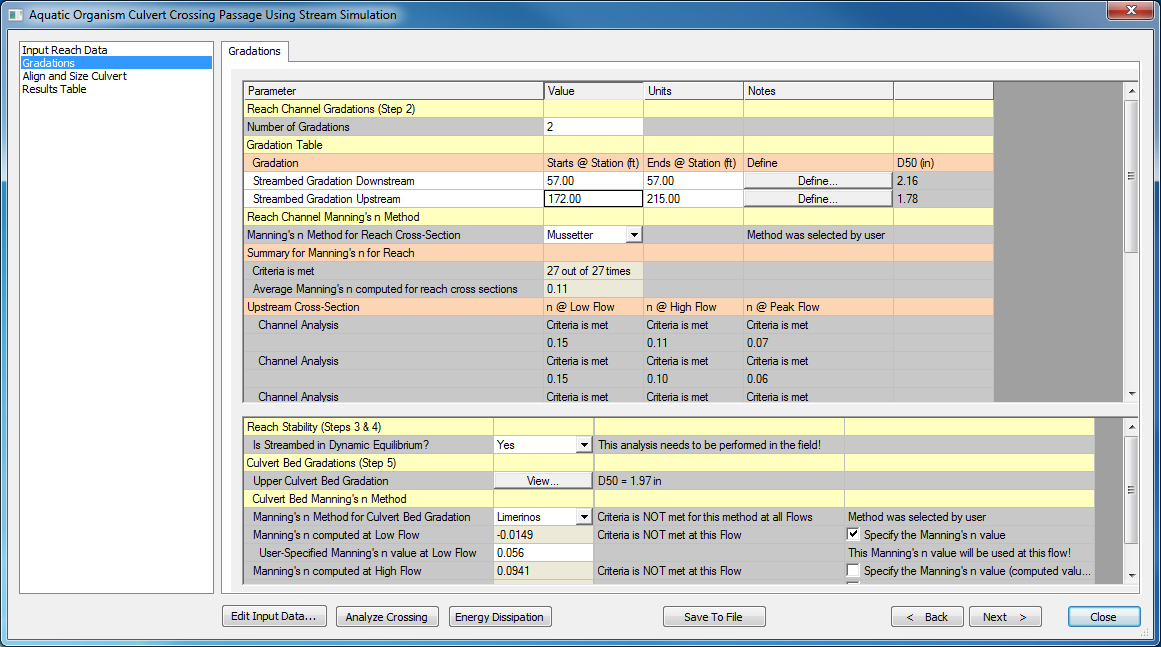HY8:AOP SS Gradations
AOP Stream Simulation, Gradation Data
The gradations are used to determine the Manning's n value for the channel and culvert as well as the stability of the embedment within the culvert.
Reach Channel Gradations
You can enter several gradations across your stream. The first value you will need to define is how many gradations you wish to enter. Then in the first column of the table, you can change the name or leave the default name. You then define where stations between which the gradation was gathered and determined from. The cross section will use the gradation that is closest to it.
You then define the gradation, which uses the 'Rock/Sediment Calculator' from Hydraulic Toolbox, developed for FHWA by Aquaveo. This calculator allows you to enter a gradation by entering a Wolman Count, an image gradation (you enter a picture of riprap with a scale, and it will calculate a gradation), or a standard riprap. The standard riprap can be personalized by installing Hydraulic Toolbox and modifying the profiles. Only one gradation is allowed to be defined at any location. When the gradation is properly defined, the calculated D50 of the gradation will show in the final column.
Finally you can select method to compute the Manning's n value. When you make a change in the definition of one of the gradation or its station, HY-8 will choose the method that has the most criteria that is met. If there is a tie, HY-8 will select the method that provides an average value that is closest to 0.03. It is recommended that you review the selected method. To learn more about the methods and the required criteria of each method, see HEC-26 Appendix C.
Once the data is entered, HY-8 will provide the number of calculations performed that met the criteria of the method selected and the average value of all the calculations given. These values are not used for any computations, but they are reported to the user to facilitate selecting a Manning's n computation method. The result of the calculation at each cross section with each flow is then reported in the final table of the spreadsheet. It is important to note that the average value of a method may be reasonable, but many of the individual calculations could still be very unreasonable.
Culvert Bed Gradations
The culvert gradations allow the user to enter two gradations. The upper layer should be similar to stream gradation, although it should be stable at the highest flow required for aquatic organism passage. The lower layer may not be necessary. The purpose is to provide stability in the embedment under peak flow, if the upper layer is unstable under the peak flow.
The user will need to define an upper layer gradation, and if desired, a lower layer gradation. Both of these gradations use the 'Rock/Sediment Calculator' from Hydraulic Toolbox, developed for FHWA by Aquaveo. This calculator allows you to enter a gradation by entering a Wolman Count, an image gradation (you enter a picture of riprap with a scale, and it will calculate a gradation), or a standard riprap. The standard riprap can be personalized by installing Hydraulic Toolbox and modifying the profiles. Only one gradation is allowed to be defined at any location. When the gradation is properly defined, the calculated D50 of the gradation will show in the final column.
Then, you can select method to compute the Manning's n value. When you make a change in the definition of one of the gradation, HY-8 will choose the method that has the most criteria that is met. If there is a tie, HY-8 will select the method that provides an average value that is closest to 0.03. It is recommended that you review the selected method. To learn more about the methods and the required criteria of each method, see HEC-26 Appendix C.
The final three rows show the results of the computations on the culvert bed.
